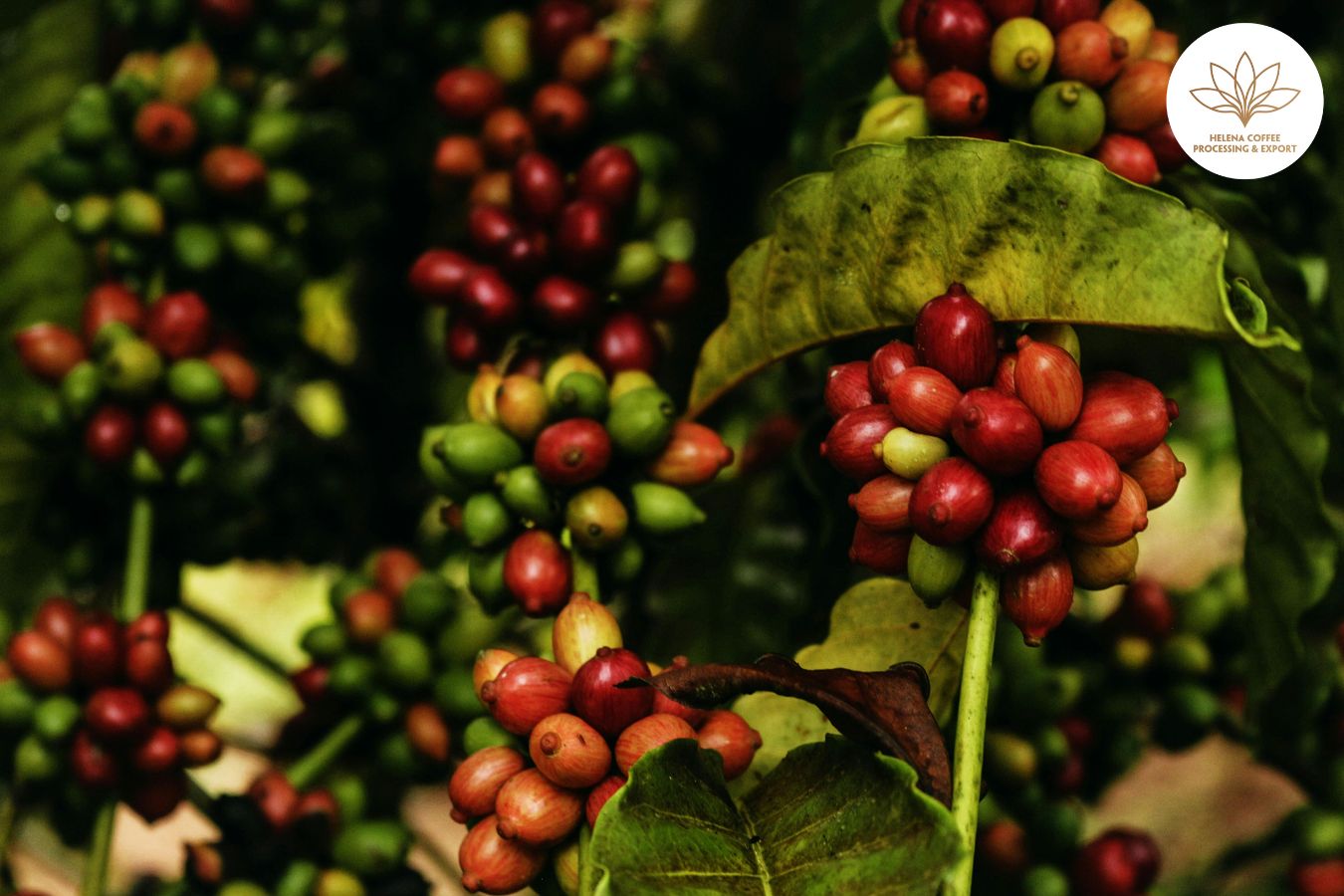
Coffee Growing: Colombia’s diverse geography, dedication to Arabica coffee production, adherence to traditional farming practices, and a rich tapestry of regional varieties have solidified its status as a leading coffee producer on the global stage.
Recent figures from the National Federation of Coffee Growers (FNC) highlight that in 2022, Colombia’s coffee production sustained impressive levels, exceeding 11.1 million bags, with exports surging to 13.1 million bags. Coffee not only plays a pivotal economic role in Colombia but is predominantly cultivated on small-scale family farms. Data from the National Survey of Coffee Growers reveals that around 89% of Colombian coffee farmers operate on less than three hectares of land.
The country is home to numerous coffee-producing regions, each distinguished by its unique microclimates, soil compositions, and altitude variations. These factors collectively influence the distinct flavor profiles, acidity, and body of the coffee produced in each region.
In a recent exploration, we delved into the coffee landscapes of Santander, Huila, Magdalena, and Quindío. Our next journey takes us to the departments of Nariño, Valle del Cauca, Tolima, and Antioquia. Read on to uncover the unique coffee cultivation stories these regions have to tell.
Department of Nariño
The Nariño Department is renowned for its deeply ingrained coffee culture, largely unaffected by the central influences of the country, making its coffee production a bastion of tradition. Here, about 27,450 hectares of land nurture coffee, tended by 34,458 devoted growers.
The farms, perched at elevations ranging from 1,600 to 2,200 meters above sea level, enjoy prime conditions for coffee cultivation. Coffee Growing: This region benefits from diverse microclimates and nutrient-rich volcanic soil, classifying it among the esteemed coffee ecotopes.
Nariño’s coffee boasts a rich variety of flavors, including notes of caramel, green fruits, and cereals, balanced with medium acidity and body. Coffee Growing: This distinct sensory profile has earned its coffees a celebrated status, particularly in the specialty coffee sector, highlighted by Nariño’s achievement in securing the first regional designation of origin for its coffee.
José Gómez, a local coffee farmer and cooperative representative, reflects on Nariño’s unique heritage: “Nariño’s culture is distinct, shaped by our history as part of the Inca empire, which influences our coffee cultivation practices.”
Despite the challenges of modernization, Nariño’s geographical advantages bolster its coffee production. “Our proximity to the equator allows for longer daylight hours, enabling cultivation at higher altitudes where the cooler climate reduces pest and disease pressures, though it does introduce risks like frost,” Gómez explains.
In recent years, Nariño’s coffee community has embraced changes to standardize processes, enhance infrastructure, and improve farm management efficiency, despite the obstacles small-scale farmers face, such as labor-intensive practices. Coffee Growing: This commitment to excellence continues to position Nariño as a leader in the production of high-quality, specialty coffees.
Valle del Cauca department
The Valle del Cauca Department, with its 51,190 hectares dedicated to coffee across 39 municipalities and a community of 22,562 coffee growers, is enriched by the contributions of Indigenous and Afro-descendant groups to its coffee culture and traditions.
Nestled between the Western and Central Cordilleras, the region enjoys a unique valley-mountain ecosystem that supports favorable climate conditions year-round, enabling two harvest seasons annually.
The coffee from Valle del Cauca is known for its intense aromas, balanced acidity, and medium body, featuring flavor notes of sweet sugarcane, citrus acidity, and red fruits, leading to a smooth, creamy finish.
Paola Andrea Pazos, an agricultural engineer and advocate for rural development, notes the diversity in what makes coffee special—be it flavor, processing, or origin. Coffee Growing: “In Valle del Cauca, the entire commercialization process is meticulously handled. For example, indigenous councils play a pivotal role in securing origin certificates for coffee, enhancing the value of the 24,905 farms in the region,” she explains.
While Valle del Cauca’s coffee cultivation may not be as technologically advanced as in regions like Quindío, its coffees are distinguished by their unique origins and the areas they are cultivated in, Pazos elaborates.
Recent efforts aim to position Valle del Cauca as a recognized specialty coffee producer. Nonetheless, the region faces challenges similar to those encountered by farmers throughout Colombia.
The geographic layout of the valley necessitates extensive travel from municipal centers to reach the rural councils. Coffee Growing: Farm sizes also vary significantly, with what’s considered a large farm in Valle only encompassing about one hectare.
Balancing modern agricultural techniques with traditional practices remains a key challenge, including the advancement of tree species by Cenicafé and equipping farmers with the necessary tools and training.
Pazos emphasizes the evolving role of rural women in coffee production, Coffee Growing: “Women are increasingly taking on significant roles, receiving training, and contributing to the development of the sector.”
Valle del Cauca stands on the cusp of great potential, with women and youth at the forefront of its development, driving the adoption of improved farming practices and shaping the future of its coffee industry.
Tolima department
Nestled among mountain ranges, hydrographic networks, and volcanic formations, Tolima is a thriving coffee cultivation hub, with 38 of its 47 municipalities dedicated to the craft. Coffee Growing: This region is home to 107,027 hectares of coffee farmland, worked by 61,849 farmers, including indigenous and Afro-descendant communities.
Prominent for growing a variety of coffee beans such as Borbón, Castillo, Costa Rica, Colombia, Caturra, Típica, and Tabí, Tolima has earned a designation of origin for its coffee, celebrated for its medium-high acidity and body. Coffee Growing: This coffee stands out with its smooth, well-balanced profile, enriched with a range of sweet, citrus, and fruity flavors.
Contributing 13.28% to the national coffee production, Tolima ranks as the country’s third largest coffee producer. Local farmers Víctor Gómez and Lucas Cabezas note the region’s shift towards specialty coffees, including Geisha, Pacamara, Tabi, and Borbón rosé varieties, positioning Tolima at the forefront of specialty coffee production in Colombia.
The region has seen significant changes with over 10,238 trees renovated and pruned in 2019, revitalizing the landscape. Víctor and Lucas highlight the global appeal of Tolima’s coffee, with the majority meeting the high standards of international markets, and coffee production accounting for 51% of the department’s income.
However, challenges such as severe weather conditions and the impact of climate change have affected production. High production costs, exemplified by the rising price of fertilizer, add to the farmers’ struggles. Coffee Growing: Despite the increasing market price of coffee, the benefits are often offset by the cost of importing fertilizers and pesticides.
Despite these hurdles, Tolima’s coffee community and local administration remain committed to enhancing the sector through training programs, aiming to sustain its position as a leading coffee producer. Víctor and Lucas emphasize the region’s dedication to quality, “Every day, we strive to produce an exceptional cup of coffee, recognizing its value as a food, treating it with care, and adopting agronomic best practices. Coffee Growing:” This collective effort underlines Tolima’s resolve to overcome obstacles and continue its tradition of excellence in coffee production.
Department of Antioquia
In the Antioquia Department, coffee cultivation spans six primary regions across 117,000 hectares, involving around 76,543 farmers. Coffee Growing: This makes it the second-largest coffee-producing area in Colombia.
Out of Antioquia’s 125 municipalities, 94 are engaged in coffee production, making the crop a central pillar of the department’s economy. Coffee Growing: It also generates over 80,000 indirect jobs during peak harvest seasons. As a vital coffee-producing region, Antioquia is estimated to produce at least 1,540,000 bags of coffee annually, with harvests occurring twice a year.
Sara Zuluaga, a second-generation coffee grower and proprietor of Cielo Tostado, observes a significant shift towards specialty coffees in Antioquia over the past decade. “Previously, our focus wasn’t on creating added value or employing distinctive processes,” she notes.
The Medellín Chamber of Commerce has been instrumental in this transformation, initiating a project in 2008 aimed at guiding small coffee farmers towards quality, environmental sustainability, women’s representation, and market access.
Despite its robust production levels, Antioquia faces the challenge of distinguishing itself within the specialty coffee sector. Coffee Growing: “We’re striving to match the prestige of regions like Huila, known for producing some of Colombia’s finest coffees,” Sara remarks.
Nevertheless, Antioquia boasts a significant competitive edge with its capital, Medellín, attracting foreign tourists and bolstering the coffee industry with an expanding network of cafés and specialty roasteries.
Sara also praises the determination and enthusiasm of the Antioqueños to embrace new techniques and lead in innovation. This mindset is pivotal for the ongoing enhancement of the region’s coffee culture. “A growing number of people are engaging with the coffee industry, shifting away from outdated practices towards a more positive approach,” she adds.
The approach to coffee cultivation and processing in Antioquia beautifully merges tradition with innovation, fostering a unique blend of heritage and progress in its coffee production.
Colombian coffee transcends its remarkable flavors to become a catalyst for community empowerment and societal transformation. Coffee Growing: This vibrant industry sustains thousands of families, stimulates economic growth, and champions sustainable farming methods.
By embracing practices like fair and direct trade, coffee growers gain access to equitable compensation for their harvests, ensuring a brighter and more secure future for themselves and their communities. Coffee Growing: This holistic approach not only enriches the coffee culture but also fortifies the fabric of society itself.
FAQS:


